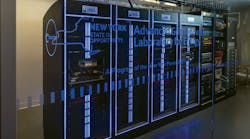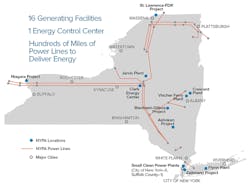Striving to become a fully digitalized utility, the New York Power Authority is exploring advanced innovative technologies and showing how it can effectively incorporate them into the state’s electricity grid. The key to this effort has been the development and operation of the Advanced Grid Innovation Laboratory for Energy (AGILe), part of an overall infrastructure modernization program intended to improve the New York Power Authority’s (NYPA’s) operational performance and efficiency.
The idea of developing a research and development facility that could serve as a collaborative environment for power system research, initially in New York but with the ambition of expanding beyond the state boundaries, was born in late 2012. At that time, NYPA set out to identify the specific needs of such a facility. This effort included benchmarking existing power systems research labs (at other utilities, academic institutions and research organizations), identifying similar ongoing efforts, soliciting feedback and input from stakeholders, and developing functional requirements and specifications for such a facility.
With AGILe, NYPA has created a lab not only based on its own needs but also for others to use to develop and test new ideas, technologies and products before potential pilot field implementations or larger-scale deployments. NYPA has invited external collaborators, such as other utilities, universities and research institutions, to use the facility, infrastructure, equipment and data as a test bed for innovative technologies. As part of the initiative, the state-owned utility has partnered with the Electric Power Research Institute (EPRI) to leverage its knowledge and expertise in the development and operation of laboratory facilities and also to obtain a better insight into the broader industry needs and future trends.
Research and Development
In December 2017, the first small-scale version of AGILe was built inside NYPA’s offices. As a proof-of-concept facility, it would enable NYPA to establish key capabilities, develop use cases, perform a variety of initial studies and projects, and work with partners and other stakeholders. It would be the basis for building a better understanding of the value a future large-scale facility could bring. Given the collaborative nature of the initiative, a memorandum of understanding was executed in April 2017 among NYPA and critical stakeholders, making AGILe a unique partnership between New York’s public electric power entities, investor-owned electric utilities and other electric power industry organizations.
Currently, AGILe is a power systems laboratory with a simulation and testing facility. Targeted research areas are as follows:
- Advanced modeling and simulation for T&D applications
- Cybersecurity testing
- Substation protection, automation and control
- Advanced sensor technologies
- Power electronics controllers.
During the initial stage, AGILe primarily comprised a digital lab that enables real-time simulations of New York state’s electrical grid. It initially targeted T&D-level research focusing on power system wide-area monitoring and control, synchrophasor applications, renewable energy integration, and substation automation and control. NYPA saw it had the potential to provide such grid benefits as accelerating and streamlining the deployment of new equipment and technologies, recreating and analyzing events and phenomena, incorporating intermittent resources, and improving reliability and bulk system control.
Over time, AGILe has gradually expanded in terms of core capabilities and functionality. The real-time grid simulator systems were initially sized to be able to simulate the entire New York state bulk power grid in real time in both the full three-phase transient-simulation domain and the positive-sequence, dynamic-simulation domain. Some of these capabilities have since expanded to enable even more detailed modeling. The systems include many analog and digital inputs/outputs and support several digital communication protocols for interfacing the simulators with external devices for software- or control-hardware-in-the loop testing. For the same purpose, the lab is equipped with multiple amplifiers to provide the appropriate voltage and current signal levels for the external connections.
One of AGILe’s main goals is to develop realistic models of New York’s electricity grid to be used as the basis for technology development and demonstration. A crucial impediment to the adoption of new technologies in the electric power industry lies in the difficulty of deploying them in the field, as this typically is complicated and risky. Thus, unless the technology is proven and mature, electric utilities are reluctant to implement pilots, let alone more extensive deployments. At the same time, most of the academic research and development, although future looking and cutting edge, typically is performed using simplistic models and synthetic data. Therefore, there is a disconnect between what is theoretically developed by research entities and what is applied in practice, creating a slow path from conceptualization to commercial implementation.
To narrow this gap, AGILe’s models of the electric power grid of New York are used as test beds for researchers to demonstrate new technologies without the complexities, costs and risks of actual field implementation. This approach lowers the risks of such new technologies for electric utilities, which can now more confidently proceed to field pilots and field installations after having set up and extensively tested new apparatus and algorithms in a realistic lab environment. AGILe’s collaborative model, with the engagement of all New York utilities as opposed to the single-entity lab model, provides a unique opportunity for achieving such goals.
The lab also focuses on two other important capabilities: modeling and simulation of communication systems and cybersecurity events as well as production-cost modeling and analysis. The first is implemented by a commercial-grade network emulator and provides a versatile environment that enables a more realistic representation of cyber-physical systems. It enables evaluation and testing of grid monitoring and control schemes, taking into consideration the performance of the communication network these schemes rely on by co-simulating the network along with the power grid. Producion-cost modeling of cybersecurity events rely on a small-scale high-performance computing (HPC) implementation of production cost simulation software. It is intended as a means for economic evaluation of new technical solutions, enabling AGILe to assess not only the engineering but also the economic impact of new technologies on the grid.
The lab also can perform more traditional offline grid simulation and data analysis tools, providing cutting-edge capabilities for research, analysis and development in the electric power industry. The lab will help to deliver, among other things, the following capabilities and outcomes:
- Advanced modeling of power grid components
- Real-time simulations of New York state’s electrical system
- Hardware- and software-in-the-loop equipment testing
- Emulation and performance characterization of power grid data communication schemes
- Automated controls to improve network resiliency, security, safety and efficiency
- Integration of large-scale renewable energy resources as well as distributed energy resources
- High level of situational awareness to enable optimal grid operation under various conditions.
Studies and Use Cases
Over its first two years of operation, AGILe has engaged in supporting a variety of collaborative research projects led by universities and other research entities, externally co-funded by organizations such as the U.S. Department of Energy (DoE) and the New York State Research and Development Authority (NYSERDA).
In 2019, NYPA completed one of its first internal studies. Protective relaying performance testing was done for a potential pilot project involving the installation of distributed flexible ac transmission system devices on one of the utility’s transmission corridors in upstate New York. This work was enabled by the lab’s real-time digital simulator, which used a detailed digital model of the region of study to run simulations of various fault conditions. By running modeling scenarios in silico, the team could determine whether the new hardware would have any unanticipated impacts on the system operation and optimize protective relaying settings before the field installation.
NYPA also initiated an internal project to evaluate, in the laboratory setup, the performance of traveling-wave-based protection and fault-location schemes. In conjunction with other testing equipment and by using very detailed grid models of the area of interest, the real-time simulators can digitally recreate the propagation of the propagation of the electromagnetic voltage and current waves that are created during a short circuit. By running various scenarios with different fault parameters, NYPA engineers can evaluate the performance of such protection schemes before the pilot field installation is scheduled to take place on two transmission lines in 2021.
Several ongoing, collaborative projects with EPRI are helping NYPA teams to prepare for a carbon-neutral future. A study on next-generation grid monitoring and control is guiding the design of a control architecture that will improve grid reliability as more carbon-free generation sources come online, enabling the grid to maintain consistent, reliable power distribution regardless of the generation source.
A second study, this one on advanced short-circuit modeling, analysis and protection schemes design for systems with renewables, models how the deployment of advanced short-circuit technology will ensure efficient protection of the grid from fluctuations caused by a mix of generation sources.
In January 2020, the final demonstration of an EPRI project on the design of adaptive oscillation damping controllers successfully took place in the lab. Co-funded by both NYPA and Terna S.p.A., the Italian grid operator, and performed in collaboration with the University of Tennessee-Knoxville, the project designed and implemented a wide-area adaptive oscillation damping controller, which used phasor measurement unit data and was capable of damping inter-area low-frequency oscillations observed after disturbance events in both the New York state and Italian transmission grids.
Researchers implemented a hardware-in-the-loop setup where controllers were physically hooked up to the AGILe digital simulator, running both the New York and Italian grid models, mimicking the device’s installation on the grid. This enabled NYPA and Terna engineers to evaluate and adjust equipment settings and confirm the device’s effectiveness.
Another project, in collaboration with Rensselaer Polytechnic Institute (RPI), is the model transformation for high-performing smart grid applications. This initiative aims to leverage expertise in computer science to improve how sophisticated smart grid models are viewed and managed across multiple simulation platforms at NYPA and beyond. The processes and technologies developed during this project could provide the cornerstone for future high-efficiency smart grid model management.
Vision and Value
Research labs have been gaining popularity with electric power utilities as an asset to help plan and prepare for the fast-changing landscape of the electricity industry.
NYPA’s vision expands beyond the technical and engineering aspects of a lab. It has created a collaborative research environment that brings people from utilities, academic institutions, technology vendors and research organizations together to work on common challenges and opportunities for the good of the industry.
For more information:
EPRI | www.epri.com
Terna | www.terna.it
University of Tennessee-Knoxville | www.utk.edu
RPI | www.rpi.edu
NYSERDA | www.nyserda.ny.gov
Department of Energy | www.doe.gov





